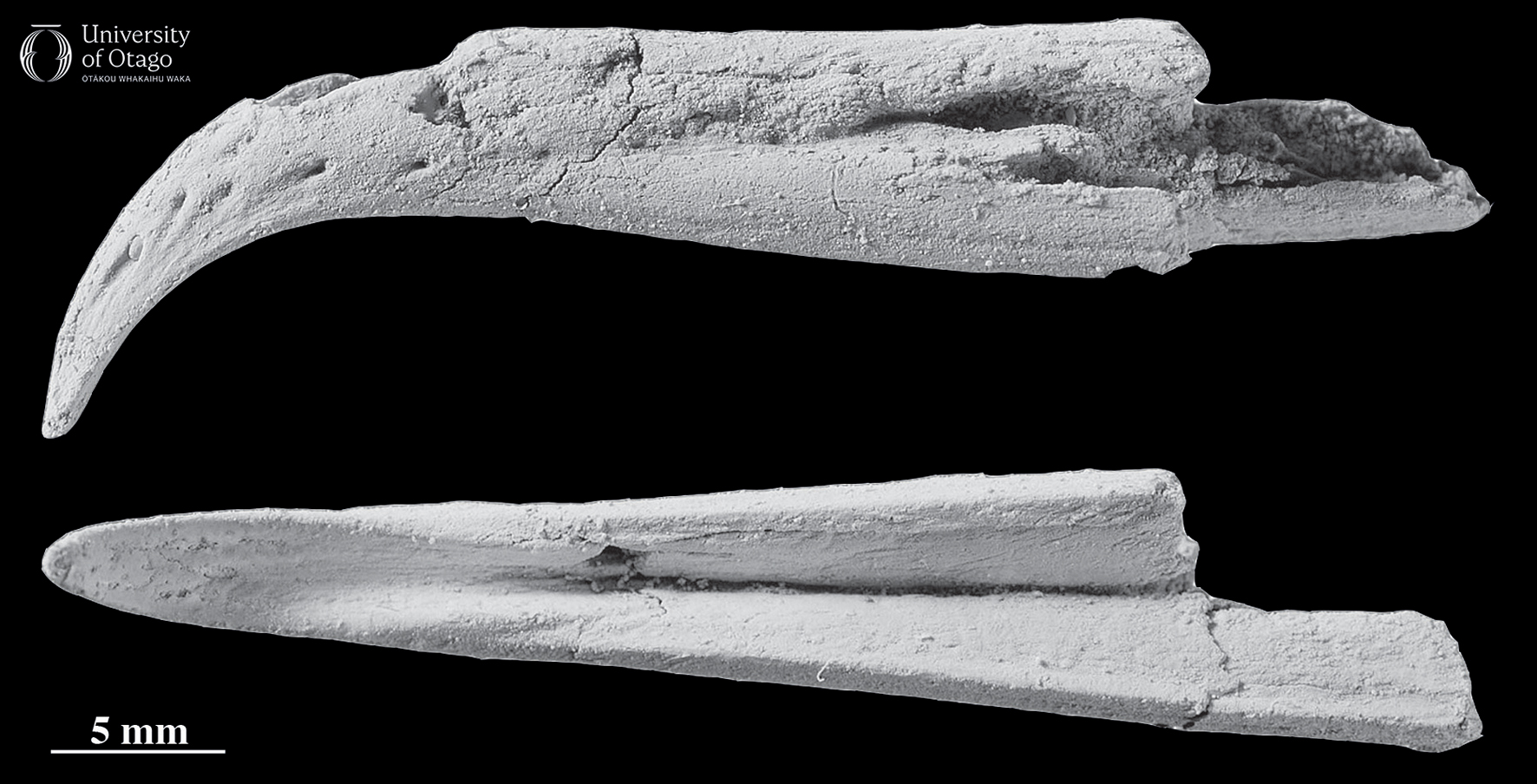20 Ancient mariner albatross soared over Zealandian oceans
Aves, Procellariiformes: Plotornis archaeonautes
Aotearoa New Zealand is a biodiversity hotspot for seabirds with more than a quarter of all seabird species breeding in the New Zealand archipelago today. Indeed, Aotearoa has endemic species within four of the five major seabird groups: Charadriiformes (e.g. tarapirohe, black-fronted tern Chlidonias albostriatus), Procellariiformes (e.g. toroa, southern royal albatross Diomedea epomophora), Sphenisciformes (e.g. hoiho, yellow-eyed penguin Megadyptes antipodes) and Suliformes (e.g. kawau pāteketeke, New Zealand king shag Leucocarbo carunculatus). The fifth group, Phaethontiformes, includes a species that is native to New Zealand but not endemic (Amokura or red-tailed tropicbird, Phaethon rubricauda). Seabirds are an important link between marine and terrestrial ecosystems by bringing nutrients onshore which then contribute to the growth of plants. The question of how long seabirds have been an important part of the ecosystems of Aotearoa is investigated by studying the fossil record. In 2024 the fossil record for albatrosses in Zealandia was revealed to be at least 22 million years old.

Beak from the ancient mariner albatross Plotornis archaeonautes (specimen OU 22690). The ancient mariner albatross was a similar size to some of the smallest albatrosses living today. Image source: Figure 2 in D Ksepka, A Tennyson, M Richards and RE Fordyce (2024) A new species of Plotornis (Aves, Pan-Diomedeidae) from the earliest Miocene of New Zealand, which is licensed under CC BY-NC-ND 4.0. Image credit: RE Fordyce. |
The partial skeleton of the fossil albatross Plotornis archaeonautes was discovered in 2010 during a field trip to a limestone quarry in South Canterbury led by Ewan Fordyce. Preparation of the fossil showed the skeleton was from a bird about the size of the smallest living species of albatross (i.e. Laysan albatross Phoebastria immutabilis, with an approximately two metre wingspan). The beak of the fossil albatross was slender compared to living species, which the researchers suggested could correspond with a more fish-intensive diet than the squid-intensive diet of albatrosses today. Recognising the fossil as a new species of Plotornis provided the earliest uncontroversial record of albatrosses in the fossil record of the Southern Hemisphere, and greatly increased the known geographic range of Plotornis to encompass both hemispheres.
Researchers haven’t yet arrived at a consensus on how long the New Zealand archipelago has been a biodiversity hotspot for seabirds. Clear supporting evidence would be needed to show that a diversity of seabird species can be consistently found in the fossil record of Aotearoa across deep time through to modern day. Although just one individual, the discovery of Plotornis archaeonautes was an important piece in this much larger story.
—Written by Daniel B Thomas
| Specimen number: OU 22690 | Age: Approximately 22.0 million years old (earliest Miocene, upper Waitakian stage) |
| Locality: Hakataramea Valley, South Canterbury | Rock Formation: Mount Harris Formation |
| Collected by: RE Fordyce and others | |
| Citation: Ksepka D, Tennyson A, Richards M, Fordyce RE. 2024. Stem albatrosses wandered far. A new species of Plotornis (Aves, Pan-Diomedeidae) from the earliest Miocene of New Zealand. Journal of the Royal Society of New Zealand 54:643–659. doi:10.1080/03036758.2023.2266390. | |
A geographic region with a higher-than-usual level of species diversity.
A bird that is dependent on offshore marine environments for finding food.
Species that are native to and found only within a specific geographic area.
An order of birds with more than 390 living species. Includes seabirds and shorebirds.
An order of seabirds with more than 140 living species across the four families Diomedeidae (albatrosses), Procellariidae (petrels and shearwater), Hydrobatidae (northern storm petrels) and Oceanitidae (southern storm petrels).
Penguins. An order of seabirds with around 20 living species in a single family (Spheniscidae). Many more extinct species of penguin are known compared with the number of living species.
An order of seabirds with more than 55 living species across the four families Fregatidae (frigatebirds), Sulidae (gannets and boobies), Phalacrocoracidae (cormorants and shags) and Anhingidae (anhingas).
An order of seabirds with three living species in a single family (Phaethontidae).
A collection of fossils that document the history of life. Reference might be made to the history of life in a particular place ('the fossil record of New Zealand'), or the history of a particular group of organisms ('the fossil record of penguins'), or simply the global history of all life ('the fossil record').
The mostly submerged continent of which New Zealand and New Caledonia are a part.

